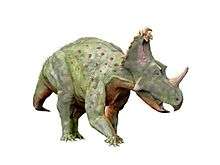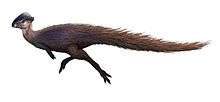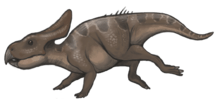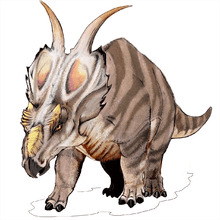Coronosaurus
| Coronosaurus Temporal range: Late Cretaceous, 77 Ma | |
|---|---|
 | |
| Restoration | |
| Scientific classification | |
| Kingdom: | Animalia |
| Phylum: | Chordata |
| Class: | Reptilia |
| Clade: | Dinosauria |
| Order: | †Ornithischia |
| Family: | †Ceratopsidae |
| Subfamily: | †Centrosaurinae |
| Genus: | †Coronosaurus Ryan, Evans & Shepherd, 2012 |
| Type species | |
| †Coronosaurus brinkmani (Ryan & Russell, 2005) | |
| Synonyms | |
|
Centrosaurus brinkmani | |
Coronosaurus is a genus of centrosaurine ceratopsian dinosaurs which contains one known species, Coronosaurus brinkmani,[1] originally classified in the genus Centrosaurus.[2] Its remains were discovered in the Oldman Formation of Alberta, Canada, dated to the Late Cretaceous (middle Campanian stage).
Discovery
Coronosaurus is known from two bone beds located in the upper unit of the Oldman Formation, of the Belly River Group. Most of the ceratopsid material, if not all, from BB 138 in Dinosaur Provincial Park, Alberta, and the MRR BB near Warner, Alberta, was referred to C. brinkmani. Bone bed 138 is located approximately fifty kilometers from Brooks, Alberta, in the Oldman Formation and 14.6 m below the contact with the Dinosaur Park Formation. It was excavated by Philip Currie between 1996 and 2000.[3] The MRR BB located approximately 180 km southwest of BB 138, is also from the Oldman Formation. These bone beds date to the middle Campanian stage of the Late Cretaceous period.[1] Both the specimens and the precise localities are archived at the Royal Tyrrell Museum of Palaeontology, in Drumheller, Alberta. The holotype of Coronosaurus is TMP 2002.68.1. It is a large adult-sized parietal with an almost complete midline bar and a partial posterior bar with left P1–P3 processes and the partially eroded right P1-P2. The specimen lacks the extreme anterior margin of the midline bar that forms the posterior wall of the frontal fontanelle and the paper-thin lateral margins that define the medial margins of the supraorbital foramina. Other significant specimens according to Ryan & Russell (2005) include TMP 2002.68.3 (a parietal), TMP 2002.68.10 (a postorbital), and TMP 2002.68.5 (supraorbitals).[1][2]
Description
Coronosaurus is a medium-sized centrosaurine ceratopsid. Gregory S. Paul in 2010 estimated its body length at five meters, its weight at two tonnes.[4] It had as an adult inflated supraorbital horncores — the "brow horns" above the eye sockets — but not elongated as in Zuniceratops, chasmosaurines, and more basal centrosaurines (like Albertaceratops and Diabloceratops), that project laterally (to the sides) over the orbit. However, as a sub-adult its postorbital horncores are pyramidal in shape with a slight lateral inflection of the distal, upper, one half. Coronosaurus is unique among ceratopsians in possessing on the rear frill of the skull a number of accessory epiparietal ossifications on its posterior parietal bar that fuse to the posterior and dorsal frill surfaces. They develop through ontogeny, the growth of the individual, as short spines that may fuse along their adjacent margins into larger, irregular bone masses. They are located close to the midline of the frill in a closely packed bunch above the base of the first epiparietal (P1), the bone spur that at each side growths downwards over the large opening in each frill half. They contribute to the substance of P1 and, through fusion, form a composite epiparietal, that is equivalent to the second epiparietal (P2) normally formed in a more lateral position. The P1 bases can thus be considered the growth positions of the second epiparietals, the P2 loci. Coronosaurus has also a uniquely shaped P3 epiparietal. It is variably developed as a short tongue-like hook or tapered spike that is oriented dorsolaterally, following the curve of the frill.[1] Otherwise, as far as is known Coronosaurus resembles Centrosaurus and Styracosaurus in its morphology. For example, the nasal of Coronosaurus closely resembles that of Centrosaurus apertus in its unfused juvenile or subadult and fused adult forms and appears to have undergone a similar ontogenetic changes. Its erect, laterally compressed nasal horn core has a blunt tip that is formed from the fusion of the opposing nasals. It sits over the posterior portion of the external nares, as it does in all centrosaurines. All juvenile and most adult specimens have gently recurved anterior and posterior margins resulting in most horns having an apex that is oriented at least slightly caudally (backwards).[2]
Phylogeny
In its original description, Ryan & Russell (2005) considered Coronosaurus to represent a new species of Centrosaurus on the basis of a small phylogenetic analysis. It included seventeen characters and nine taxa. Coronosaurus (as C. brinkmani) and C. apertus grouped at the base of the Centrosaurinae, while Styracosaurus was found to be more closely related to Pachyrhinosaurus, and other derived centrosaurines, than to Centrosaurus. In 2011, Anthony R. Fiorillo and Ronald S. Tykoski modified the analysis of Currie et al. (2008), with 54 characters, to include more taxa, such as C. brinkmani. They found C. brinkmani to be the sister taxon of the clade Styracosaurus plus C. apertus, while Pachyrhinosaurus and other derived centrosaurines were in a separate lineage. Thus, this analysis found no support for the monophyly of Centrosaurus.[5] Later, Farke et al. (2011) used 97 morphological characters to assess the phylogenetic position of a new taxon which they named Spinops. Spinops was found to be in a polytomy with Centrosaurus apertus, C. brinkmani and Styracosaurus, and therefore C. brinkmani was excluded from the analysis to increase the resolution.[6] Finally, Ryan, Evans & Shepherd (2012) used the data matrix of Farke et al. (2011) to assess the phylogenetic position of Xenoceratops. Their revised analysis had significantly better resolution than that presented by Farke et al. (2011), probably due in part to the additional scoring of missing characters for some taxa based on direct observation of their specimens. For example, five additional characters were scored for C. brinkmani. In the resultant tree it was found to be in more advanced position than Spinops and C. apertus, as the sister taxon of Styracosaurus. Thus the new generic name, Coronosaurus, was given to it. The cladogram below shows Coronosaurus phylogenetic position among other centrosaurines following Ryan, Evans & Shepherd (2012).[1]
| Ceratopsidae |
| ||||||||||||||||||||||||||||||||||||||||||||||||||||||||||||||||||||||||||||||||||||
| |
Etymology
The type species of Coronosaurus, Centrosaurus brinkmani, was first described and named by Michael J. Ryan and Anthony P. Russell in 2005. Michael J. Ryan, David C. Evans and Kieran M. Shepherd erected the genus Coronosaurus for C. brinkmani in 2012 as Centrosaurus apertus and C. brinkmani did not form a monophyletic clade in several recent phylogenetic analyses. The generic name is derived from the Latin corona, meaning "crown" in reference to the multiple occurrences of extra epiparietals that cover the posterior margin of its parietal, giving it a crown-like appearance, and saurus (Latinized from Greek sauros), meaning "lizard".[1] The specific name brinkmani honors Donald Brinkman, for his research in palaeoecology of the Late Cretaceous environments of Alberta.[2]
Paleoecology
Fauna and habitat
Studies suggest that the paleoenvironment of the Oldman Formation was an ancient coastal plain.[7] In addition to remains of Coronosaurus, this formation has produced the remains of the theropods Saurornitholestes, Daspletosaurus, Troodon, Dromaeosaurus and Hesperonychus, the ceratopsids Albertaceratops, Chasmosaurus, and Anchiceratops, the hadrosaurids Brachylophosaurus, Gryposaurus, Parasaurolophus, and Corythosaurus, the ornithopod Albertadromeus and the ankylosaurid Scolosaurus.
See also
References
- 1 2 3 4 5 6 Ryan, M. J.; Evans, D. C.; Shepherd, K. M.; Sues, H. (2012). "A new ceratopsid from the Foremost Formation (middle Campanian) of Alberta". Canadian Journal of Earth Sciences. 49 (10): 1251. doi:10.1139/e2012-056.
- 1 2 3 4 Ryan, M. J.; Russell, A. P. (2005). "A new centrosaurine ceratopsid from the Oldman Formation of Alberta and its implications for centrosaurine taxonomy and systematics". Canadian Journal of Earth Sciences. 42 (7): 1369. doi:10.1139/e05-029.
- ↑ M.J. Ryan and A.P. Russell, 2003, "New centrosaurine ceratopsids from the late Campanian of Alberta and Montana and a review of contemporaneous and regional patterns of centrosaurine evolution", Journal of Vertebrate Paleontology 23(3): 91A
- ↑ Paul, G.S., 2010, The Princeton Field Guide to Dinosaurs, Princeton University Press p. 260
- ↑ Fiorillo, A. R.; Tykoski, R. S. (2012). "A new Maastrichtian species of the centrosaurine ceratopsid Pachyrhinosaurus from the North Slope of Alaska". Acta Palaeontologica Polonica. 57 (3): 561. doi:10.4202/app.2011.0033.
- ↑ Farke, A. A.; Ryan, M. J.; Barrett, P. M.; Tanke, D. H.; Braman, D. R.; Loewen, M. A.; Graham, M. R. (2011). "A New Centrosaurine from the Late Cretaceous of Alberta, Canada, and the Evolution of Parietal Ornamentation in Horned Dinosaurs". Acta Palaeontologica Polonica. 56 (4): 691. doi:10.4202/app.2010.0121.
- ↑ Eberth, D.A., and Hamblin, A.P., 1993 , Tectonic, stratigraphic, and sedimentologic significance of a regional discontinuity in the upper Judith River Group (Belly River wedge) of southern Alberta, Saskatchewan, and northern Montana : Canadian Journal of Earth Sciences, 30, 174‒200.


